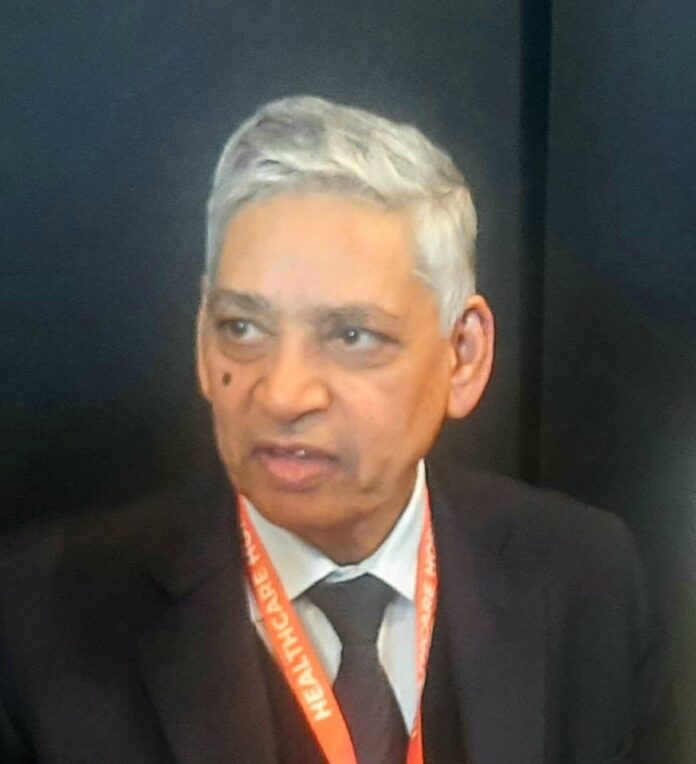Renowned cardiologist Dr. Kewal Kishan Talwar, a Padma Bhushan Awardee, currently serves as the Chairman of PSRI Hospital. His distinguished career includes past roles as the chairman of the Medical Council of India, head of the cardiology department at AIIMS, New Delhi, and Director of the PGIMER, Chandigarh.
Before his tenure at PSRI Hospital, Dr. Talwar spent over six years as the Chairman of the Cardiology Department at Max Super Speciality Hospital, Saket. Notably, he achieved the first implantation of Implantable Cardioverter-Defibrillator (ICD) therapy in South Asia, earning a place in the LIMCA Book of World Records in 1997. Additionally, he introduced Cardiac Resynchronization Therapy in India, also acknowledged in the LIMCA Book of World Records.
Accolades for Dr. Talwar include the prestigious Dr. B. C. Roy Award, the highest honor in the medical category in India. He has served as the President of the National Academy of Medical Sciences (NAMS) and is a fellow of the Indian National Science Academy (INSA). In 2006, the Government of India bestowed upon him the Padma Bhushan for his significant contributions to the field of medicine.
Dr. Talwar’s impactful work extends to the development of Cardiac Arrhythmia as a specialty in India and the establishment of the Heart Failure & Heart Transplant program at AIIMS. His extensive research is reflected in numerous publications, comprising 240 articles and 270 abstracts in various peer-reviewed medical journals, along with 15 chapters contributed to medical texts.
In an insightful discussion with The Interview World, Dr. Kewal Kishan Talwar emphasizes the diverse factors influencing cardiac diseases. He advocates for the enhancement of public healthcare infrastructure and the delivery of affordable healthcare for all. Here are the key highlights from his interview.
Q: What is the current state of the healthcare infrastructure in India to deliver superior cardiac care?
A: In our country today, there are healthcare centers that offer cutting-edge cardiac care comparable to global standards, and remarkably, at a very affordable cost. Therefore, it seems imperative for the public sector to further expand its involvement in this domain. This would enable individuals unable to afford private healthcare to access quality services through the public sector.
Anticipating the establishment of new AIIMS (All India Institutes of Medical Sciences), there is an expectation that comprehensive improvements will be introduced. Assuredly, healthcare services are likely to become more economically accessible. Addressing affordability stands out as a crucial societal and governmental responsibility. This underscores the significance of collaborative efforts, including charitable organizations.
The process involves establishing hospitals and subsequently ensuring their services are economically viable. It is a common belief that government investments should primarily focus on strengthening the public sector. Simultaneously, there is a call to actively support charitable initiatives, creating an environment that aids patients. Acknowledging the importance of all sectors, the central theme remains affordable healthcare.
Ultimately, the key lies in garnering governmental support to fortify public healthcare infrastructure, fostering an inclusive and accessible healthcare system for all.
Q: How might we optimize and streamline the drug discovery process within our country to significantly enhance its speed and efficiency?
A: When it comes to drug discovery, it is crucial to invest significantly in this field. Establishing a robust foundation for drug discovery is of utmost importance. This involves fostering a research-oriented culture and embracing a perspective that acknowledges the inevitability of failures in the research process. Success in research is not guaranteed, and failure should be regarded as a natural part of the journey.
One key challenge is that many companies are hesitant to invest in research due to the uncertainty of outcomes; they prioritize immediate returns. Addressing this issue requires creating arrangements and incentives that encourage investment in research endeavors.
Additionally, there is a challenge in allopathic medication involving different phases (phase 0, 1, 2) and the need for extensive experimental work before reaching phase 0 and 1. Unfortunately, there is a lack of facilities to support this large-scale experimentation. Recently, some progress has been made in Hyderabad with the setup initiated by ICMR. However, to compete globally in this field, we must take courageous steps.
For instance, consider the case of a specialized device for the heart, often referred to as an artificial heart device, costing around one crore. While we are developing this device, testing an experimentation with this device is taking place in Australia. We lack the necessary facilities for such endeavors.
Therefore, there is an urgent need to establish comprehensive research centers capable of providing end-to-end facilities for both developing new technologies and simultaneously testing them. Building such centers will be essential to propel advancements in drug discovery and medical research, enabling us to stay competitive on a global scale.
Q: What factors contribute to an increased risk of heart attacks in younger individuals?
A: We’ve received data from a university in the USA shedding light on the reasons behind the increasing incidence of heart attacks among young people. The contributing factors are multifaceted. Genetic predisposition stands out as a significant element. Additionally, there are social risk factors, with smoking emerging as the most prevalent among young individuals experiencing heart attacks.
Another concern is the rise of drug abuse among the younger demographic, particularly in school settings. Sedentary lifestyles, marked by a lack of exercise, are also identified as contributors. It’s crucial to emphasize the importance of educating them about incorporating regular exercise into their routines.
Engaging in consistent physical activity brings about various health benefits. To minimize the risk of heart attacks, it’s imperative for them to steer clear of unhealthy habits such as consuming junk food, smoking, and excessive alcohol consumption. These lifestyle choices are major contributors to the vulnerability of younger individuals to heart-related issues.
Stress emerges as a paramount factor affecting the younger generation, presenting a significant challenge. As a practicing cardiologist, I observe that today’s youth experience more stress compared to our own past experiences. Factors contributing to this include increased workload in multiple jobs, unlike the job security prevalent in the past.
Moreover, the societal expectations add to the stress; individuals not only worry about themselves but also about their families, parents, siblings, and the broader society. Recognizing stress as a pervasive issue, it becomes crucial to create an environment that fosters mental well-being. Educating them about the importance of exercise becomes a practical approach to alleviating stress.
While practical solutions are vital, we also need to address the need for social security. In the corporate world, it’s becoming increasingly common for young individuals to express fears about potential health issues, even leading them to spend money on preventive testing due to job-related anxieties.
In conclusion, a comprehensive approach that combines practical education on exercise, lifestyle choices, and the provision of social security measures is necessary to address the rising risk of heart attacks among the younger generation. It is essential to create an environment that not only encourages physical well-being but also supports mental health in the face of modern-day stressors.
Q: What role do social determinants of health play in shaping the current health landscape, and how do they influence the overall well-being of individuals and communities?
A: The importance of social determinants of health cannot be overstated. Pollution is a significant issue in this context, and understanding our environment is crucial. Even if we don’t actively smoke, constant exposure to pollutants is akin to smoking. Therefore, environmental factors are integral to the social determinants of health.
Another critical aspect is the modification of food habits, necessitating strict legislation. Addressing this issue through laws is essential. Additionally, sanitation plays a pivotal role in ensuring overall health and well-being.
Moving on to the topic of water quality, especially in terms of maintaining good health, proper measures can prevent both communicable and non-communicable diseases. This brings us to the subject of exercise. Unfortunately, the current school system allocates limited time for physical activity, and often, children lack adequate play areas in urban settings.
To address this, there is a need for a proactive approach. Schools should consider dedicating specific hours to sports, perhaps on Saturdays. While it may seem like a small change, it can significantly contribute to the health of the nation. Establishing a mechanism to implement these elements is crucial for maintaining public safety and well-being.
Q: What is the significance of medical insurance in light of the increasing costs of healthcare expenses?
A: Currently, the private sector’s healthcare costs are excessively high. Without health insurance, individuals find themselves in a vulnerable position. Although the government has extended health insurance coverage to 10 crore families, a significant portion of the Indian middle class remains uninsured.
When an individual is medically insured today, there’s a willingness to seek care at private hospitals without hesitation. However, a substantial portion of this demographic still lacks insurance coverage.
I hope that the present government takes proactive measures to introduce subsidized insurance for these unprivileged groups. This could involve a shared contribution, with families and the government each covering a portion of the costs. Such a step is crucial, in my opinion.
Implementing this could be of immense societal benefit, instilling confidence in individuals regarding their healthcare coverage.
Q: How would you assess the quality of healthcare services in India?
A: Today, we can take pride in the advancements within the healthcare sector. Our hospitals and expertise now stand on par with global standards, allowing us to effectively address a wide range of healthcare challenges. Notably, the quality of care we deliver rivals that of Western nations, but at a fraction of the cost – less than one-tenth, to be precise.
This has led to an influx of patients from abroad seeking our healthcare services. They recognize that our quality matches that of the best hospitals in developed nations, yet our affordability sets us apart. Undoubtedly, the expertise we possess positions us as formidable contenders in the international healthcare landscape.
Moreover, our doctors exemplify a unique compassion that distinguishes them. Comparatively, the compassion instilled in Indian doctors often exceeds that which is imparted elsewhere. The public and local communities express a heightened sense of satisfaction when consulting Indian doctors, attributing it to the compassionate approach ingrained in our medical professionals. In the realm of medicine, dedication is paramount, and our doctors consistently exemplify devotion to their patients. This blend of expertise, affordability, and compassion underscores the strength of our healthcare system, making it a source of pride for our nation.



